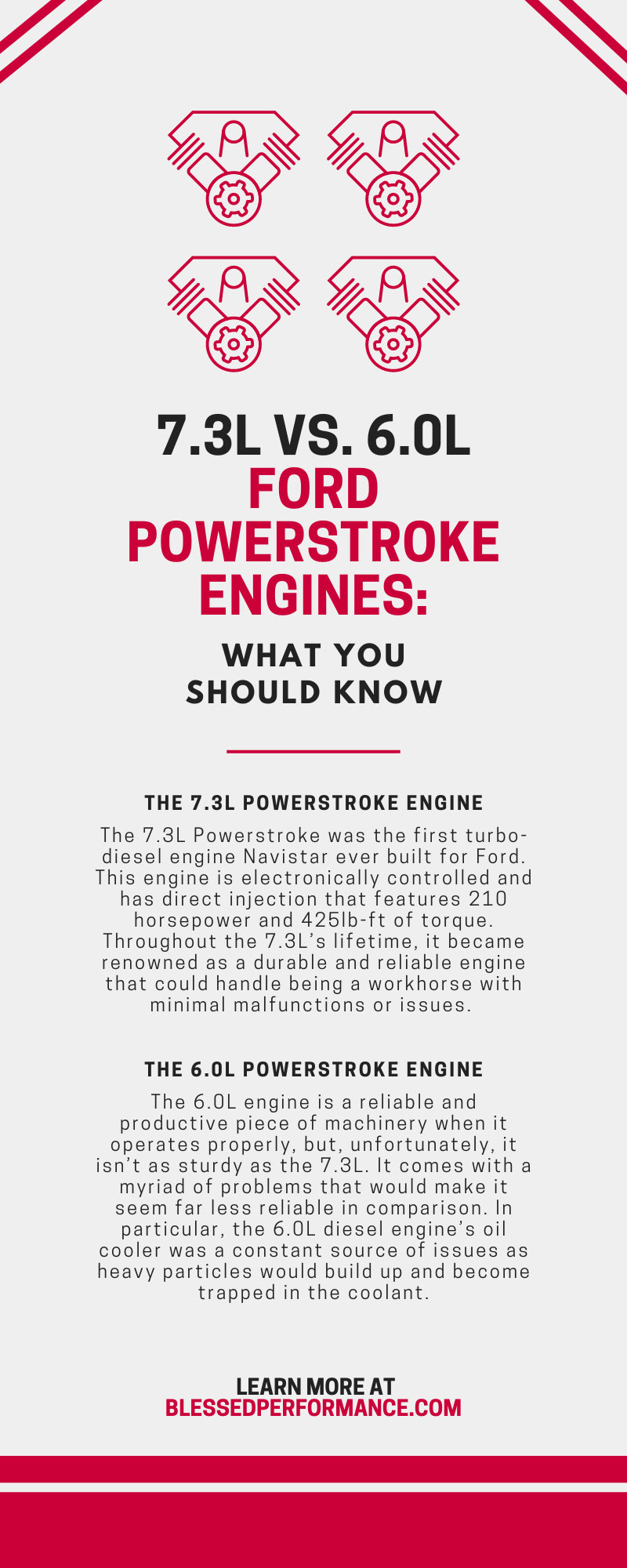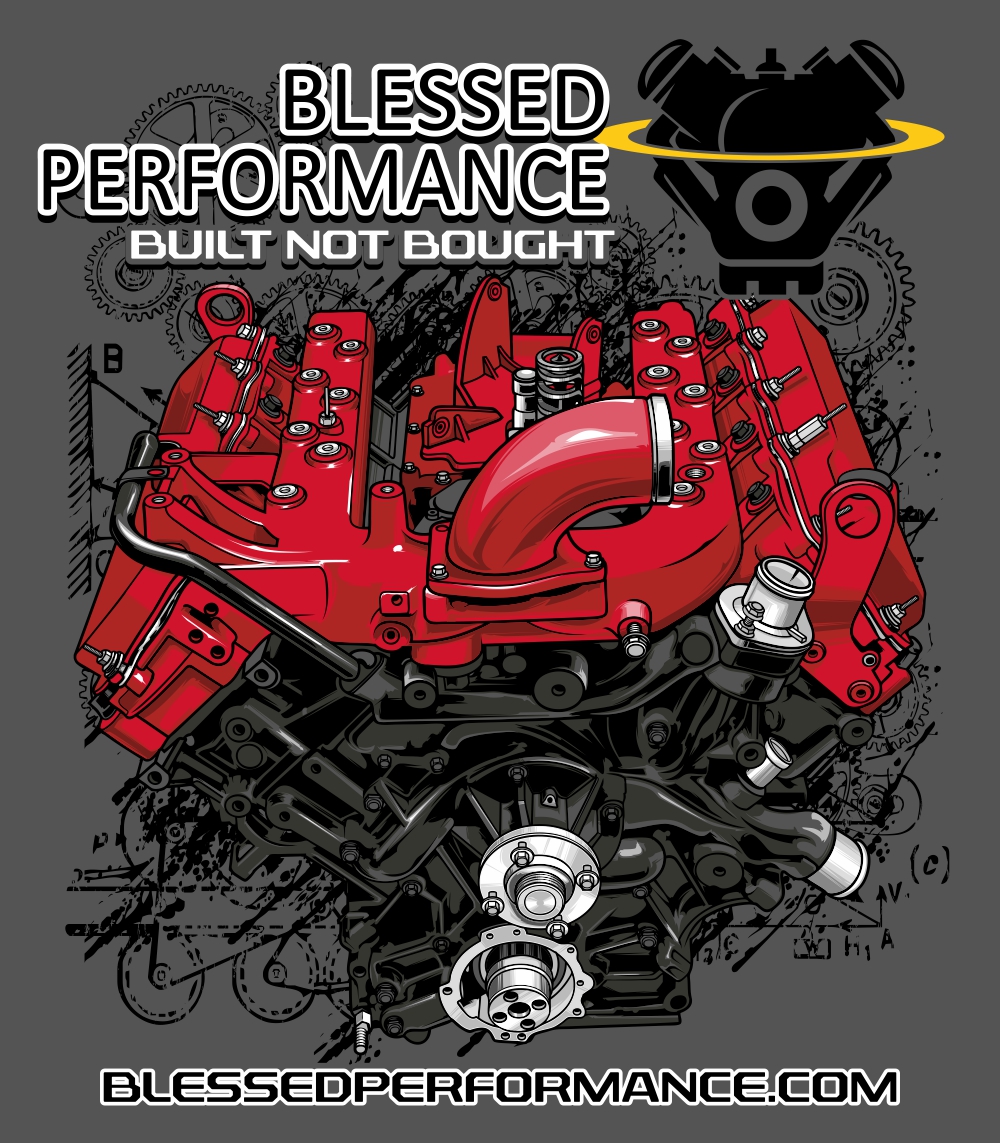7.3L vs. 6.0L Ford Powerstroke Engines: What You Should Know
13th Dec 2022
In the middle of 2003, Ford officially began phasing out the 7.3L Powerstroke engine in favor of the 6.0L version. This replacement would prove to be controversial among truck owners, even though Navistar designed both engines. If you’re not as informed about diesel engines, allow us to tell you what you should know about 7.3L vs. 6.0L Ford Powerstroke engines. Understanding how each engine functions and what their flaws are can help you better tune your engine and have superior performance.
The 7.3L Powerstroke Engine
The 7.3L Powerstroke was the first turbo-diesel engine Navistar ever built for Ford. This engine is electronically controlled and has direct injection that features 210 horsepower and 425lb-ft of torque. Throughout the 7.3L’s lifetime, it became renowned as a durable and reliable engine that could handle being a workhorse with minimal malfunctions or issues. Although Ford has phased them out of production, there are still thousands of diesel trucks sporting 7.3L engines that function well to this day.
The 6.0L Powerstroke Engine
Navistar’s second turbo-diesel engine would feature 325 horsepower and 560lb-ft of torque. On the surface, this seems like nothing but an upgrade, so why isn’t it as popular as the 7.3L? The 6.0L engine is a reliable and productive piece of machinery when it operates properly, but, unfortunately, it isn’t as sturdy as the 7.3L. It comes with a myriad of problems that would make it seem far less reliable in comparison. In particular, the 6.0L diesel engine’s oil cooler was a constant source of issues as heavy particles would build up and become trapped in the coolant.
Why Ford Changed Engines
So if 7.3L Powerstroke crate engines performed better and boasted more popularity, why did they replace them with the 6.0L? As emission standards become stricter, they needed an engine that could meet those ever-changing emission standards. The 6.0L does that.
While the 6.0L could have used the basic architecture and design of the 7.3L, there were a few additions that made the design incompatible. These were the inclusion of an EGR, a more efficient fuel injection system, and a variable geometry turbocharger. Furthermore, if they recycled the design of the 7.3L, there’d be no guarantee that horsepower would increase. They had uprated the 7.3L five times already just to get up to 275hp and 525lb-ft of torque. And even then, it still fell short of the power that GM’s 6.6L Duramax engine put out.
To keep up with their competition while adhering to new emission standards, Ford chose the 6.0L, as it was more powerful than their competitor’s.
Comparing Components
While we’ve established that the 6.0L Powerstroke didn’t live up to the popularity of the 7.3L, Navistar replaced or added various components to provide a host of benefits. In order to get a good idea of what you should know about the 7.3L and 6.0L Ford Powerstroke engines, let’s take a closer look at some individual parts.
Turbochargers
The 7.3L Powerstroke always used a fixed geometry Garrett turbocharger with a 60mm compressor wheel—although this turbocharger came in three different forms over the 7.3L’s production lifespan. This turbocharger would prove to be reliable at stock or slightly over stock power levels, but it lacked responsiveness compared to the 6.0L. This would make the 7.3L feel a tad laggy, but you could always expect consistent performance.
In contrast, the 6.0L Powerstroke uses a Garrett turbo with a variable geometry design. This means that the exhaust turbine’s housing size can change depending on the throttle position of the truck. Furthermore, the turbocharger’s housing employs a vane-style turbine in which steel vanes can instantly alter the velocity at which exhaust hits the turbine wheel. Because the housing can change depending on RPM, this turbocharger has excellent performance at both low and high RPMs.
Injectors
Both the 7.3L and 6.0L employ a hydraulically activated and electronically controlled unit injector system. They use high-pressure oil pumps so that engine oil can, essentially, fire the fuel injectors. The 7.3L engine used a gear-driven, fixed displacement pump, which was at the front of the lifter valley.
The 6.0L Powerstroke’s high-pressure oil pump is also gear-driven, but it’s instead at the rear of the engine. Unfortunately, the oil pump is less reliable than the one used on the 7.3L, and trying to address the issue of a failed oil pump is often a messy process. Plus, the pump is beneath a cover under the turbocharger, making it difficult to access.
Valves
So why would the 6.0L Powerstroke use an inferior oil pump? Well, a component within the pump, the spool valve, allows for high-pressure oil to enter the injector. This valve has a tighter tolerance and more advanced injection system than the 7.3L’s, which uses poppet valves. The 6.0L can produce higher injection pressures, at an upward of 3,600psi compared to the 7.3L’s 3,000psi. However, this comes at the cost of the service life.
Bed Plate
One unique aspect of the 6.0L Powerstroke’s design is the bed plate. This bed plate is one of the 6.0L’s greatest boons, as it helps the 6.0L engine withstand a lot more horsepower than the 7.3L could ever handle. With the bed plate, your stock connecting rods are good for up to 750–800 rwhp, and you won’t need to upgrade the valve train until you’ve gained significantly more horsepower and boost. In comparison, the 7.3L needs stiffer valve springs and stronger pushrods to exceed its comparatively meager horsepower.
Exhaust Gas Recirculation (EGR)
Another big addition to 6.0L Powerstroke engines, and also perhaps the most infamous, was the inclusion of an EGR. This component recirculates finely metered quantities of exhaust fuel back into the engine intake system for greater engine efficiency and reduced fuel consumption. However, the big problem is that carbon build-up and soot would clog or damage these EGRs.
Conclusion
While the 7.3L Powerstroke engine undoubtedly had fewer issues, it’s also a weaker engine. With proper care, your 6.0L Powerstroke can be as quality as 7.3L Powerstroke engines. Furthermore, no matter which diesel engine you have installed, Blessed Performance can help compensate for issues and maximize performance with our various high-quality performance parts and tuning.


